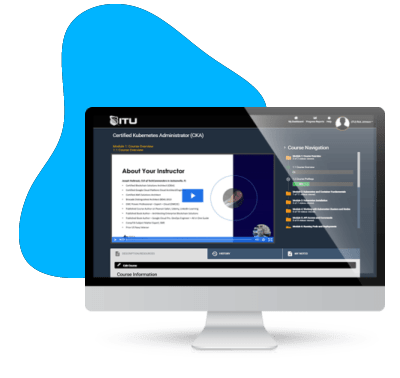
Lifetime
An ITU Online Training exclusive. The only Buy Once, Never Pay for IT training again program available. Plus, get all new and updated content for life.

With an All-Access Pass, you get access to every current and future ITU course. Access over 2,500 hours of on-demand IT Training 24/7. With over 13,000 on-demand training videos and 19,000+ practice questions, you'll have the tools to excel in the critical IT skills needed to elevate your IT Career. Our All-Access pass is available in three affordable plans.
Paris is the capital of France.
Tokyo is the capital of Japan.
Most Popular
Categories


With an All-Access Pass, you get access to every current and future ITU course. Access over 2,500 hours of on-demand IT Training 24/7. With over 13,000 on-demand training videos and 19,000+ practice questions, you'll have the tools to excel in the critical IT skills needed to elevate your IT Career. Our All-Access pass is available in three affordable plans.

ITU provides a vast array of IT-focused on-demand training designed to help you excel in both entry-level and advanced IT skills. Browse our most popular training or take a deper dive into our robust catalog of training categories.
Popular Courses All Categories





Future proof your networking skills with our Network Administrator training series. In this series, you’ll explore and learn concepts that are common between all network systems and dive deeper into specific networks like Cisco, Microsoft, Linux, Azure, Google Cloud and Amazon Web services. This series is a must for anyone wanting to become an IT network administrator and future proof our career path.
$129.00 $51.60
Live labs expand your training experience by allowing you to learning by doing in real-time virtual server environments. The following labs can optionally be included in this training series.
Closed Captions
Certificate of Completion

A network administrator plays a crucial role in any organization that relies on computer networks. Their primary responsibilities include:
In summary, a network administrator ensures that an organization’s computer networks are well-maintained, secure, and efficient. Their role is vital in ensuring seamless communication and data flow within an organization, which is crucial for the day-to-day operations and long-term success of the business.
Module 0 - Course introduction
0.1 Instructor Intro
0.2 Course Overview
Module 1 - Networking Fundamentals
1.1 Intro to Networking
1.1.1 Activity: Creating a Network
1.2 Common Terminology
1.2.1 Activity: Examining Ports and Sockets
1.3 OSI Model
1.4 DoD Model
1.4.1 Activity: Examining Network Layers
1.5 TCP, UDP, IP
1.5.1 Activity: Examining TCP
1.5.2 Activity: Examining UDP
1.5.3 Activity: Examining IP
1.6 ICMP, IGMP, ARP
1.6.1 Activity: Examining ICMP
1.6.2 Activity: Examining ARP
1.6.3 Activity: Examining IGMP
1.7 Network Topologies
1.8 Network Types
1.9 Part 1: Network Characteristics
1.9 Part 2: Network Characteristics
1.10 Module 1 outro
Module 2 - Cables and Connectors
2.1 Ethernet Standards
2.2 Copper Cable Types
2.3 Fiber Optic Cable Types
2.4 Connector Types
2.4.1 Activity: Selecting the Right Cable
2.5 Media Converters and Transceivers
2.6 Cable Management
2.7 Module 2 Outro
Module 3 - Internet Protocol (IP)
3.1 IPv4 Basics
3.2 IP Packet and Interface Types
3.2.1 Activity: Configuring Client IP Settings
3.3 Binary Numbering System
3.4 Classful and Classless Addressing
3.5 Understanding CIDR Notation
3.6 IPv4 Subnetting Method
3.7 Verifying with Binary
3.8 Finding Subnet IDs
3.8.1 Activity: Subnetting a Class C Network
3.9 The Delta in Action
3.9.1 Activity: Subnetting With the Delta
3.10 Subnetting Based on Hosts
3.11 Subnetting in Other Octets
3.12 Supernetting
3.12.1 Activity: Supernetting
3.13 IPv6
3.14 IPv4 - IPv6 Transition Mechanisms
3.15 Module 3 Outro
Module 4 - Layer 7 Protocols
4.1 Remote Control Protocols
4.2 File Sharing Protocols
4.3 Web Protcols
4.4 Email Protocols
4.5 Database Protocols
4.6 Voice Protocols
4.7 Security Protocols
4.8 Management Protocols
4.9 Module 4 Outro
Module 5 - Network Services
5.1 DHCP
5.1.1 Activity: Configuring DHCP
5.1.2 Activity: Configuring a DHCP Relay Agent
5.2 DNS
5.2.1 Activity: Configuring DNS - Part 1
5.2.2 Activity: Configuring DNS - Part 2
5.3 NTP
5.4 Corporate and Datacenter Network Architecture
5.5 Cloud Concepts and Connectivity Options
5.6 Module 5 Outro
Module 6 - Networking Devices
6.1 Introductory Concepts
6.2 Repeaters and Hubs
6.2.1 Activity: Connecting Devices with a Hub
6.3 Bridges and Switches
6.3.1 Activity: Connecting Devices with a Switch
6.4 Routers and Multilayer Switches
6.5 Security Devices
6.6 Modems
6.7 Module 6 Outro
Module 7 - Networked Devices
7.1 IP Devices
7.2 IoT
7.2.1 Activity - Programming IoT Devices
7.3 ICS/SCADA
7.4 Module 7 Outro
Module 8 - Routing and Bandwidth Management
8.1 Routing Basics
8.1.1 Activity: Configuring Static Routes
8.2 Packet Delivery on the Same Network
8.3 IP Routing Across a Single Router
8.4 IP Routing Across Multiple Hops
8.4.1 Activity: Static Routes - CHALLENGE
8.5 Route Selection
8.6 RIP
8.6.1 Activity: Configuring RIP - CHALLENGE
8.7 OSPF
8.8 EIGRP
8.9 BGP
8.10 NAT/PAT
8.11 Bandwidth Management (with Module 8 Outro)
Module 9 - Ethernet Switching
9.1 Ethernet Basics
9.2 Switching Overview
9.2.1 Activity: Examining a MAC Table
9.3 VLANs
9.3.1 Activity: Creating VLANs
9.4 VLAN Trunking
9.4.1 Activity: Configuring VLAN Trunking
9.5 VLAN Routing
9.5.1 Activity: Configuring VLAN Routing
9.6 Contention Management
9.7 Switchport Configuration (with Module 9 Outro)
Module 10 - Wireless Technologies
10.1 Wireless Overview
10.2 Radio Basics
10.3 Modulation
10.4 Wi-Fi Standards
10.5 Antennas
10.6 Wi-Fi Service Sets
10.7 Wi-Fi Security
10.8 Cellular
Module 11 Network Performance
11.1 Monitoring Performance
11.2 Common Metrics
11.2.1 Activity: Examining Interface Statistics
11.3 SNMP
11.4 Netflow
11.5 Network Security Monitoring (with Module 11 Outro)
Module 12 High Availability and Disaster Recovery
12.1 HA and DR Concepts
12.2 High Availability Mechanisms
12.3 Disaster Recovery Mechanisms
12.4 Facility and Infrastructure Support (with Module 12 Outro)
Module 13 Organizational Documents
13.1 Plans and Procedures
13.2 Security Policies
13.3 Loss Prevention
13.4 Common Agreements
13.5 Common Documentation
13.6 Structured Cabling - MDF and IDF
13.7 Horizontal and Vertical Cabling
13.7.1 Activity - Implementing Cable Management
13.8 Labeling
13.9 Surveys and Assessments (with Module 13 Outro)
Module 14 Network Security
14.1 Common Security Concepts
14.2 Common Attack Types
14.3 Spoofing-based Attacks
14.4 Hijacking and MITM
14.5 Social Engineering
14.6 Network Segmentation
14.7 Private VLANs
14.8 Single Organization Authentication
14.9 Extending Authentication
14.10 Authorization
14.11 Network Device Hardening
14.12 Wireless Security
14.13 Remote Access Security
14.14 IoT Security
14.15 Physical Security (with Module 14 Outro)
Module 15 Network Troubleshooting
15.1 Troubleshooting Methodology
15.2 Physical Connectivity Issues
15.3 Hardware Testing Tools
15.3.1 Activity - Testing an Ethernet Cable
15.3.2 Activity - Crimping on an RJ-45 Connector
15.3.3 Activity - Punching Down Twisted Pair
15.3.4 Activity - Using a Telephone Toner
15.4 Understanding Electricity
15.4.1 Activity - Checking Cable Continuity
15.4.2 Activity - Testing DC Voltage
15.4.3 Activity - Testing AC Voltage
15.5 Twisted Pair Pinout Problems
15.6 Twisted Pair Termination Problems
15.7 Repairing Damaged Twisted Pair Cable
15.8 Fiber Optic Connectivity Issues
15.8.1 Activity - Testing a Fiber Optic Cable
15.9 Common Port Problems
15.9.1 Working with Ports and Their Devices
15.10 Common Software Testing Tools
15.10.1 Activity - Scanning for Open Ports
15.11 Common Command Line Utilities
15.12 Troubleshooting Basic IP Networking Issues
15.13 Common Switching Issues
15.14 Switching Test Tools and Techniques
15.15 Common IP Routing Issues
15.16 Wi-Fi Access Point Issues
15.17 Wirelss Interference
15.17.1 Activity - Using a Spectrum Analyzer
15.18 Wireless Antenna Issues
15.18.1 Activity - Configuring a Wi-Fi Router
15.19 WAP Placement Strategies
15.20 Infrastructure Service Issues (DHCP)
15.21 Infrastructure Service Issues (DNS)
15.22 Infrastructure Service Issues (NTP)
15.23 Fireall / ACL Issues
15.24 VPN Issues
15.25 Additional Network Security Troubleshooting and Tips
15.26 Advanced Networking Issues
15.27 Troubleshooting Server Services (with Module 15 Outro)
CompTIA Network+ N10-008 Course Outro
Module 1 Understanding Local Area Networking
Module 1 Notes
1.0 Intro to Networking Fundamentals
1.1 Exam Overview
1.1 Examining Local Network Devices and Data Transfers 1a
1.1 Examining Local Network Devices and Data Transfers 1b
1.1 Examining Local Network Devices and Data Transfers 1c
1.1 Examining Local Network Devices and Data Transfers 1d
1.1 Examining Local Network Devices and Data Transfers 1e
1.1 Examining Local Network Devices and Data Transfers 1f
1.2 Examining Local Network Devices and Data Transfers Part 2a
1.2 Examining Local Network Devices and Data Transfers Part 2b
Module 2 Defining Networks with the OSI Model
Module 2 Notes
2.1 Defining Networks with OSI Model Part 1a
2.2 Defining Networks with OSI Model Part 1b
2.3 Defining Networks with OSI Model Part 1c
2.4 Defining Networks with OSI Model Part 1d
2.5 Defining Networks with OSI Model Part 1e
2.6 Defining Networks with OSI Model Part 1f
2.7 Defining Networks with OSI Model Part 1g
2.8 Defining Networks with OSI Model Part 1h
Module 3 Understanding Wired and Wireless Networks
Module 3 Notes
3.1 Understand Wired and Wireless Networks Part1
3.2 Understand Wired and Wireless Networks Part2
Module 4 Understanding Internet Protocol
Module 4 Notes
4.1 Understanding Internet Protocol Part1
4.2 Understanding Internet Protocol Part2
Module 5 Implementing TCP-IP in the command line
Module 5 Notes
5.1 Implementing TCPIP in the Command Line
Module 6 Working with Networking Services
Module 6 Notes
6.1 Working with Networking Services
Module 7 Understanding Wide Area Networks
Module 7 Notes
7.1 Understanding Wide Area Network Part1
7.2 Understanding Wide Area Network Part2
Module 8 Defining Network Infrastructure and Security
Module 8 Notes
8.1 Defining Network Infrastructure & Network Security Part1
8.2 Defining Network Infrastructure & Network Security Part2
Module 9 Key Takeaways
Key Takeaway Notes
1. Key Take Aways of Networking Fundamentals
2. Key Take Aways Mod1
3. Key Take Aways Mod2
4. Key Take Aways Mod3
5. Key Take Aways Mod4
6. Key Take Aways Mod5
7. Key Take Aways Mod6
8. Key Take Aways Mod7
Module 10 Terms to Know
Terms to Know Notes
1. Terms to Know Networking Fundamentals
2. Terms to Know Mod1
3. Terms to Know Mod2
4. Terms to Know Mod3
5. Terms to Know Mod4
6. Terms to Know Mod5
7. Terms to Know Mod6
8. Terms to Know Mod7
9. Terms to Know Mod8
Module 1: Intro & Performing Basic Linux Tasks
Instructor Introduction
Course Introduction
Identify The Linux Design Philosophy
Enter Shell Commands
Shell Commands Activity
Get Help with Linux
Module 2: Managing Users and Groups
Assume Superuser and Groups
Create, Modify, and Delete Users
Create, Modify, and Delete Groups
Query Users and Groups
Configure Account Profiles
Module 3: Managing Permissions and Ownership
Modify File and Directory Permissions
Modify File and Directory Ownership
Configure Special Permissions and Attributes
Troubleshoot Permissions Issues
Module 4: Managing Storage
Create Partitions
Manage Logical Volumes
Mount File Systems
Manage File Systems
Navigate the Linux Directory Structure
Troubleshoot Storage Issues
Module 5: Managing Files and Directories
Create and Edit Text Files
Search for Files
Perform Operations on Files and Directories
Process Text Files
Manipulate File Output
Module 6: Managing Kernel Modules
Explore the Linux Kernel
Install and Configure Kernel Modules
Monitor Kernel Modules
Module 7: Managing the Linux Boot Process
Configure Linux Boot Components
Configure GRUB
Module 8: Managing System Components
Configure Localization Options
Configure GUIs
Manage Services
Troubleshoot Process Issues
Troubleshoot CPU and Memory Issues
Module 9: Managing Devices
Identify the Types of Linux
Configure Devices
Monitor Devices
Troubleshoot Hardware Issues
Module 10: Managing Networking
Identify TCP/IP Fundamentals
Identify Linux Server Roles
Connect to a Network
Configure DHCP and DNS Client Services
Configure Cloud and Virtualization Technologies
Troubleshoot Networking Issues
Module 11: Managing Packages and Software
Identify Package Managers
Manage RPM Packages with YUM
Manage Debian Packages with APT
Configure Repositories
Acquire Software
Build Software from Source Code
Troubleshoot Software Dependency Issues
Module 12: Securing Linux Systems
Implement Cybersecurity Best Practices
Implement Identity and Access Management Methods
Configure SELinux or AppArmor
Configure Firewalls
Implement Logging Services
Back Up, Restore, and Verify Data
Module 13: Working with Bash Scripts
Customize the Bash Shell Environment
Identify Scripting and Programming Fundamentals
Write and Execute a Simple Bash Script
Incorporate Control Statements in Bash Scripts
Module 14: Automating Tasks
Schedule Jobs
Implement Version Control Using Git
Identify Orchestration Concepts
Module 15: Installing Linux
Prepare for Linux Installation
Perform the Installation
Module 1: Exploring the Functions of Networking
Course Introduction
Instructor Introduction
Exploring the Functions of Networking Pt 1
Exploring the Functions of Networking Pt 2
Module 2: Introducing the Host-To-Host Communications Model
Introducing the Host-To-Host Communications Model Pt 1
Introducing the Host-To-Host Communications Model Pt 2
Module 3: Introducing LANs
Introducing LANs
Get Started with CLI Demo Pt 1
Get Started with CLI Pt Demo 2
Adding Descriptions to Interfaces Demo
Configure Gateway on a Switch Demo
Visualize Interfaces and Statistics Demo
Show Version Command Demo
CDP Demo
Module 4: Exploring the TCP/IP Link Layer
Exploring the TCP-IP Link Layer Pt 1
Exploring the TCP-IP Link Layer Pt 2
Module 5: Subnetting
Subnetting Pt 1
Subnetting Pt 2
Subnetting Pt 3
Subnetting Pt 4
Subnetting Pt 5
Subnetting Pt 6
Module 6: Explaining the TCP/IP Transport Layer and Application Layer
Explaining the TCP-IP Transport Layer and Application Layer Pt 1
Explaining the TCP-IP Transport Layer and Application Layer Pt 2
Explaining the TCP-IP Transport Layer and Application Layer Pt 3
Module 7: Exploring the Functions of Routing
Exploring the Functions of Routing Pt 1
Exploring the Functions of Routing Pt 2
Exploring the Functions of Routing Pt 3
Configuring RIP Demo
EIGRP Demo Pt 1
EIGRP Demo Pt 2
Module 8: Exploring the Packet Delivery Process
Exploring the Packet Delivery Process
Module 9: Troubleshooting a Simple Network
Troubleshooting a Simple Network
Module 10: Introducing Basic IPv6
Introducing Basic IPv6 Pt 1
Introducing Basic IPv6 Pt 2
Introducing Basic IPv6 Pt 3
Introducing Basic IPv6 Pt 4
Introducing Basic IPv6 Pt 5
Introducing Basic IPv6 Pt 6
Introducing Basic IPv6 Pt 7
Introducing Basic IPv6 Pt 8
IPV6 Basic Configuration and SLAAC Demo Pt 1
IPV6 Basic Configuration and SLAAC Demo Pt 2
IPV6 Routing Demo Pt 1
IPV6 Routing Demo Pt 2
IPV6 Static Routes Demo
Module 11: Configuring Static Routing
Configuring Static Routing
Static Routes Demo
Module 12: Implementing VLANs and Trunks
Implementing VLANs and Trunks Pt 1
Implementing VLANs and Trunks Pt 2
Implementing VLANs and Trunks Pt 3
Implementing VLANs and Trunks Pt 4
Spanning-tree Protocol Demo Pt 1
Spanning-tree Protocol Demo Pt 2
Spanning-tree Protocol Demo Pt 3
Module 13: Routing Between VLANs
Routing Between VLANs
Inter VLAN Routing Demo
Module 14: Introducing OSPF
Introducing OSPF Pt 1
Introducing OSPF Pt 2
Introducing OSPF Pt 3
Introducing OSPF Pt 4
OSPF Single Area Demo Pt 1
OSPF Single Area Demo Pt 2
OSPF Multiple Area Demo Pt 1
OSPF Multiple Area Demo Pt 2
Module 15: Building Redundant Switched Topologies
Building Redundant Switched Topologies Pt 1
Building Redundant Switched Topologies Pt 2
Module 16: Improving Redundant Switched Topologies with EtherChannel
Improving Redundant Switched Topologies with Ether Channel Pt 1
Improving Redundant Switched Topologies with Ether Channel Pt 2
Configuring Ether Channel Demo
Module 17: Exploring Layer 3 Redundancy
Exploring Layer 3 Redundancy
Module 18: Introducing WAN Technologies
Introducing WAN Technologies Pt 1
Introducing WAN Technologies Pt 2
Introducing WAN Technologies Pt 3
Introducing WAN Technologies Pt 4
Introducing WAN Technologies Pt 5
Introducing WAN Technologies Pt 6
Module 19: Explaining Basics of ACL
Explaining Basics of ACL Pt 1
Explaining Basics of ACL Pt 2
Explaining Basics of ACL Pt 3
Module 20: Enabling Internet Connectivity
Enabling Internet Connectivity
DHCP Demo
Static NAT Demo
PAT Using Specific IP Demo
PAT Using IP of Interface Demo
Module 21: Introducing QoS
Introducing QoS Pt 1
Introducing QoS Pt 2
Introducing QoS Pt 3
Introducing QoS Pt 4
Introducing QoS Pt 5
Module 22: Introducing Architectures and Virtualization
Introducing Architectures and Virtualization Pt 1
Introducing Architectures and Virtualization Pt 2
Introducing Architectures and Virtualization Pt 3
Introducing Architectures and Virtualization Pt 4
Module 23: Introducing System Monitoring
Introducing System Monitoring Pt 1
Introducing System Monitoring Pt 2
Introducing System Monitoring Pt 3
Module 24: Managing Cisco Devices
Managing Cisco Devices Pt 1
Managing Cisco Devices Pt 2
NTP Demo
Syslog Demo
Module 25: Examining the Security Threat Landscape
Examining the Security Threat Landscape Pt 1
Examining the Security Threat Landscape Pt 2
Module 26: Implementing Threat Defense Technologies
Implementing Threat Defense Technologies Pt 1
Implementing Threat Defense Technologies Pt 2
Implementing Threat Defense Technologies Pt 3
Implementing Threat Defense Technologies Pt 4
Implementing Threat Defense Technologies Pt 5
Authentication Protocols Demo Pt 1
Authentication Protocols Demo Pt 2
Device Hardening Demo Pt 1
Device Hardening Demo Pt 2
Device Hardening Demo Pt 3
Port Security Demo
Module 27: Exam Preparation
Exam Prep Tips
Module 28: Practice Demos
Get Started with CLI Demo Pt 1
Get Started with CLI Pt Demo 2
Adding Descriptions to Interfaces Demo
Configure Gateway on a Switch Demo
Visualize Interfaces and Statistics Demo
Show Version Command Demo
CDP Demo
Static Routes Demo
DHCP Demo
Static NAT Demo
PAT Using Specific IP Demo
PAT Using IP of Interface Demo
Configuring RIP Demo
Configuring Ether Channel Demo
Inter VLAN Routing Demo
Spanning-tree Protocol Demo Pt 1
Spanning-tree Protocol Demo Pt 2
Spanning-tree Protocol Demo Pt 3
EIGRP Demo Pt 1
EIGRP Demo Pt 2
Authentication Protocols Demo Pt 1
Authentication Protocols Demo Pt 2
NTP Demo
Syslog Demo
Device Hardening Demo Pt 1
Device Hardening Demo Pt 2
Device Hardening Demo Pt 3
Port Security Demo
OSPF Single Area Demo Pt 1
OSPF Single Area Demo Pt 2
OSPF Multiple Area Demo Pt 1
OSPF Multiple Area Demo Pt 2
IPV6 Basic Configuration and SLAAC Demo Pt 1
IPV6 Basic Configuration and SLAAC Demo Pt 2
IPV6 Routing Demo Pt 1
IPV6 Routing Demo Pt 2
IPV6 Static Routes Demo
Module 1 - Introduction to Security
1.1 Introduction to Security
Module 2 - Malware and Social Engineering Attacks
2.1 Malware and Social Engineering Attacks
Module 3 - Basic Cryptography
3.1 Basic Cryptography
Module 4 - Advanced Cryptography and PKI
4.1 Advanced Cryptography and PKI
Module 5 - Networking and Server Attacks
5.1 Networking and Server Attacks
Module 6 - Network Security Devices, Designs and Technology
6.1 Network Security Devices, Designs and Technology
Module 7 - Administering a Secure Network
7.1 Administering a Secure Network
Module 8 - Wireless Network Security
8.1 Wireless Network Security
Module 9 - Client and Application Security
9.1 Client and Application Security
Module 10 - Mobile and Embedded Device Security
10.1 Mobile and Embedded Device Security
Module 11 - Authentication and Account Management
11.1 Authentication and Account Management
Module 12 - Access Management
12.1 Access Management
Module 13 - Vulnerability Assessment and Data Security
13.1 Vulnerability Assessment and Data Security
Module 14 - Business Continuity
14.1 Business Continuity
Module 15 - Risk Mitigation
15.1 Risk Mitigation
Module 16 - Security Plus Summary and Review
16.1 - Security Plus Summary and Review
Module 17 - Hands-On Training
17.1 Hands-On Scanning Part 1
17.2 Hands-On Scanning Part 2
17.3 Hands-On Advanced Scanning
17.4 Hands-On MetaSploit
17.5 Hands-On BurpSuite
17.6 Hands-On Exploitation Tools Part 1
17.7 Hands-On Exploitation Tools Part 2
17.8 Hands-On Invisibility Tools
17.9 Hands-On Connect to Tor
Module 1: Security and Risk Management
Introduction
CIA Triad Security Governance - Part 1
CIA Triad Security Governance - Part 2
Compliance Legal And Regulatory Issues - Part 1
Compliance Legal And Regulatory Issues - Part 2
Understanding Professional Ethics - Part 1
Understanding Professional Ethics - Part 2
Risk Management - Part 1
Risk Management - Part 2
Threat Modeling Acquisition Strategy And Practice Security Awareness And Training - Part 1
Threat Modeling Acquisition Strategy And Practice Security Awareness And Training - Part 2
Module 2: Asset Security
Asset Security - Part 1
Asset Security - Part 2
Module 3: Security Engineering
Engineering And Management Of Security - Part 1
Engineering And Management Of Security - Part 2
Engineering And Management Of Security - Part 3
Engineering And Management Of Security - Part 4
Engineering And Management Of Security - Part 5
Engineering And Management Of Security - Part 6
Module 4: Communication and Network Security
Apply Secure Design Principles To Networks - Part 1
Apply Secure Design Principles To Networks - Part 2
Apply Secure Design Principles To Networks - Part 3
Apply Secure Design Principles To Networks - Part 4
Apply Secure Design Principles To Networks - Part 5
Apply Secure Design Principles To Networks - Part 6
Securing Network Components - Part 1
Securing Network Components - Part 2
Design And Establish Secure Communication Channels - Part 1
Design And Establish Secure Communication Channels - Part 2
Design And Establish Secure Communication Channels - Part 3
Module 5: Identity and Access Management
Controlling Access And Managing Identity - Part 1
Controlling Access And Managing Identity - Part 2
Controlling Access And Managing Identity - Part 3
Controlling Access And Managing Identity - Part 4
Module 6: Security Assessment Testing
Designing Performing And Analyzing Security Testing
Module 7: Security Operations
Foundational Concepts And Investigations - Part 1
Foundational Concepts And Investigations - Part 2
Incident Management And Preventative Measures - Part 1
Incident Management And Preventative Measures - Part 2
Disaster Recovery Process - Part 1
Disaster Recovery Process - Part 2
Module 8: Software Development Security
Understanding Applying And Enforcing Software Security - Part 1
Understanding Applying And Enforcing Software Security - Part 2
Conclusion
The Network Administrator Training Series is a comprehensive program designed to equip aspiring and current network administrators with a robust set of skills and knowledge essential for managing and securing modern network infrastructures. This series encompasses a range of courses, each targeting a specific aspect of network administration, ensuring a well-rounded educational experience. From foundational networking concepts to advanced security protocols, the series offers a progressive learning path that is both thorough and practical.
At the outset, courses like CompTIA Network+ N10-008 and Microsoft Networking Fundamentals lay the groundwork, introducing learners to the basics of network design, operations, and Microsoft-specific networking technologies. These foundational courses are crucial for building a solid understanding of network infrastructures, which is further enhanced by specialized training in Linux systems through the CompTIA Linux+ course, an important skill set given Linux’s prevalence in server environments. The Cisco 200-301: Cisco Certified Network Associate (CCNA) course then takes learners deeper into the realm of Cisco’s network solutions, covering a wide range of topics from network fundamentals to more complex concepts like advanced security and network automation.
As the series progresses, it emphasizes the growing importance of cybersecurity in network administration. The CompTIA Security+ SY0-601 course introduces critical cybersecurity principles, equipping learners with the knowledge to safeguard networks against emerging threats. For those aspiring to senior roles, the Certified Information Systems Security Pro (CISSP) course delves into advanced security management and best practices, essential for overseeing comprehensive network security strategies. Overall, the Network Administrator Training Series is an invaluable resource for anyone looking to start or advance their career in network administration, providing the tools and insights needed to excel in this dynamic and ever-evolving field.
Based on experience level and location, the table below provide estimates of the annual salary for Network Administrators.
| City | Low Salary (USD) | Median Salary (USD) | High Salary (USD) |
|---|---|---|---|
| New York City | $60,000 | $80,000 | $110,000 |
| Los Angeles | $55,000 | $75,000 | $105,000 |
| Chicago | $50,000 | $70,000 | $100,000 |
| Houston | $45,000 | $65,000 | $95,000 |
| San Francisco | $65,000 | $85,000 | $120,000 |
| Boston | $60,000 | $80,000 | $110,000 |
| Dallas | $50,000 | $70,000 | $100,000 |
| Atlanta | $45,000 | $65,000 | $95,000 |
| Washington, D.C. | $65,000 | $85,000 | $120,000 |
| Seattle | $60,000 | $80,000 | $110,000 |
| Miami | $50,000 | $70,000 | $100,000 |
In general, Network Administrators play a critical role in maintaining an organization’s IT infrastructure, including networks, servers, and security systems. Here are some key points to consider regarding the job outlook for Network Administrators:
To get the most current job outlook for Network Administrators, we recommend consulting job market reports, IT industry news, and job postings in your desired location. Additionally, networking with professionals in the field and joining relevant online forums or LinkedIn groups can provide valuable insights into the current job market conditions.
This comprehensive training series is best suited for a diverse range of individuals at various stages of their career in IT and network administration. Here’s a list of who would benefit most from this training:
This training series caters to a diverse audience, ensuring that participants from various backgrounds and career stages are well-equipped for the dynamic and evolving field of network administration.
A network administrator is responsible for managing and maintaining an organization’s computer networks. This includes tasks like installing and configuring network hardware and software, monitoring network performance, ensuring network security, troubleshooting network issues, and providing technical support for network-related problems.
Typically, a network administrator is expected to have at least a bachelor’s degree in computer science, information technology, network administration, or a related field. However, some positions may accept equivalent experience or certifications such as CompTIA Network+, Cisco’s CCNA, or Microsoft’s network administration certifications in lieu of a degree.
Essential skills include a strong understanding of network infrastructure and protocols, proficiency in configuring and managing network hardware (like routers, switches, and firewalls), knowledge of security practices, problem-solving abilities, and good communication skills. Familiarity with various operating systems and networking software is also crucial.
A network administrator can advance to higher roles such as a senior network administrator, network manager, or IT director. With additional certifications and experience, they may also specialize in areas like network security (becoming a network security analyst or engineer) or move into related fields like systems administration or cloud computing.
Network administrators are needed in virtually all industries that use networked computers and systems. This includes technology companies, financial institutions, healthcare organizations, educational institutions, government agencies, and more. The role is critical in any sector where maintaining a reliable and secure network is essential for daily operations.

Unlock endless learning opportunities with over 2,500 hours of IT training at our lowest price ever. Plus, get all new and updated online courses for free while your subscription remains active.
Cancel at your convenience. This exceptional deal on IT training provides you access to high-quality IT education at the lowest monthly subscription rate in the market. Boost your IT skills and join our journey towards a smarter tomorrow.
Mary Beth helped me. She was wonderful.